Pinworm Infection, also known as Enterobiasis or Oxyuriasis, is one of the most common intestinal parasitic infections worldwide. It mostly affects children, although it can occur in individuals of any age.1Vermund, Sten H., and Craig M. Wilson. “Pinworm (Enterobius vermicularis).” Seminars in Pediatric Infectious Diseases. Vol. 11. No. 4. WB Saunders, 2000. A small white parasitic Enterobius vermicularis (pinworm) causes this disease and belongs to the group nematodes (Nematoda). Pinworm infection is highly contagious and can spread easily in crowded places like schools, daycare centers, and institutes.
Lifecycle of Pinworm
The first step in pinworm infection is accidentally ingesting pinworm eggs. These tiny eggs can easily be picked up from contaminated surfaces or transferred from hand to mouth, especially in crowded areas.
Once the eggs are ingested, the next stage is for them to travel down the digestive tract and hatch in the small intestine. From there, the larvae travel to the large intestine, where they mature and become adult worms. This process can take up to approximately 1-2 months. After the adult worms are developed, they travel to the anus and lay their eggs there primarily at nighttime. This nocturnal migration leads to the characteristic hallmark symptom of pinworm infection, which is intense anal itching.
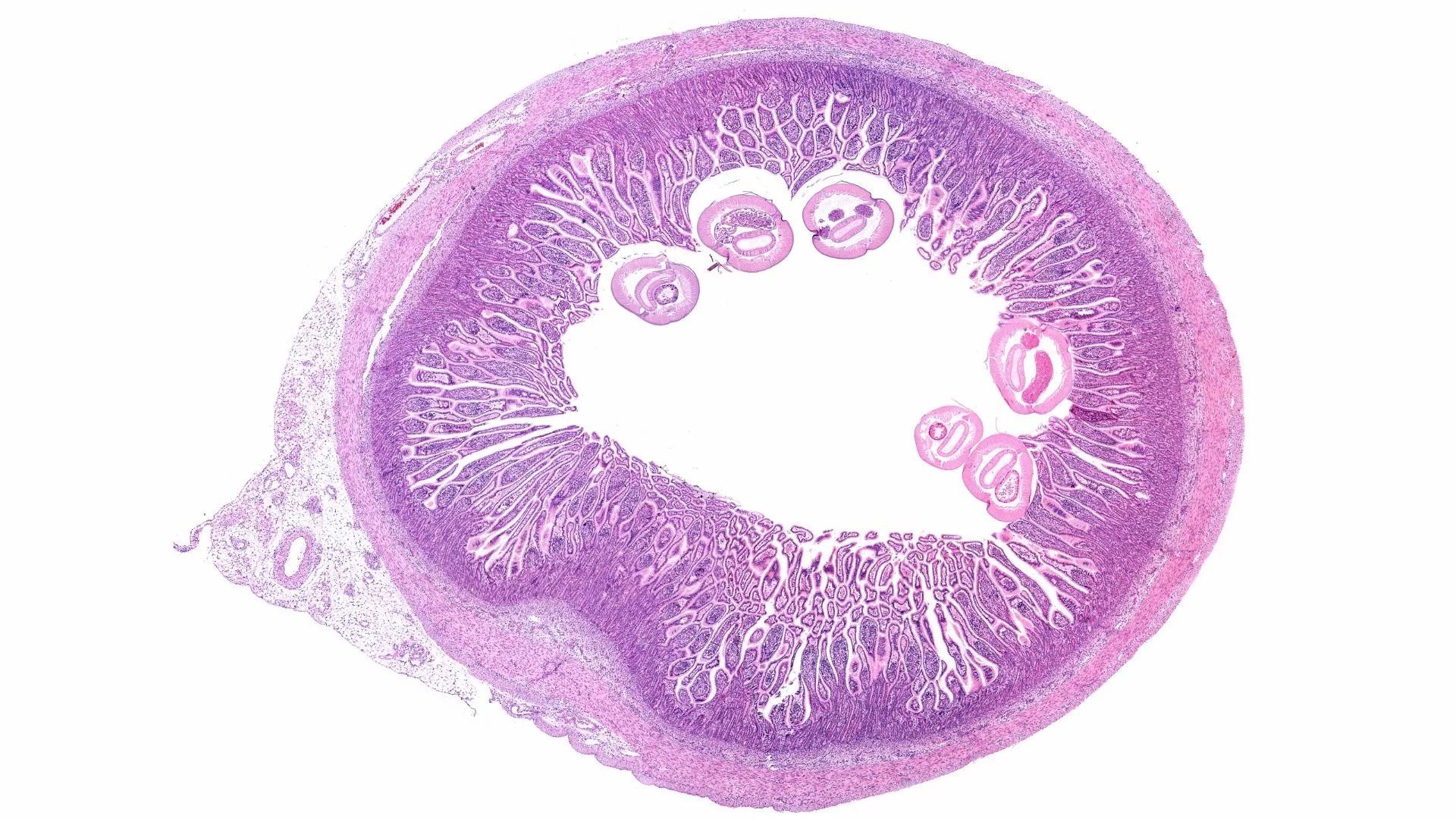
This itching triggered by female pinworms laying eggs leads to the patient scratching their anus, which results in the further spread of the infection. Eggs get stuck to the finger and can easily be transferred to other surfaces and objects. The cycle of infection continues to repeat if hygiene practices are poor.
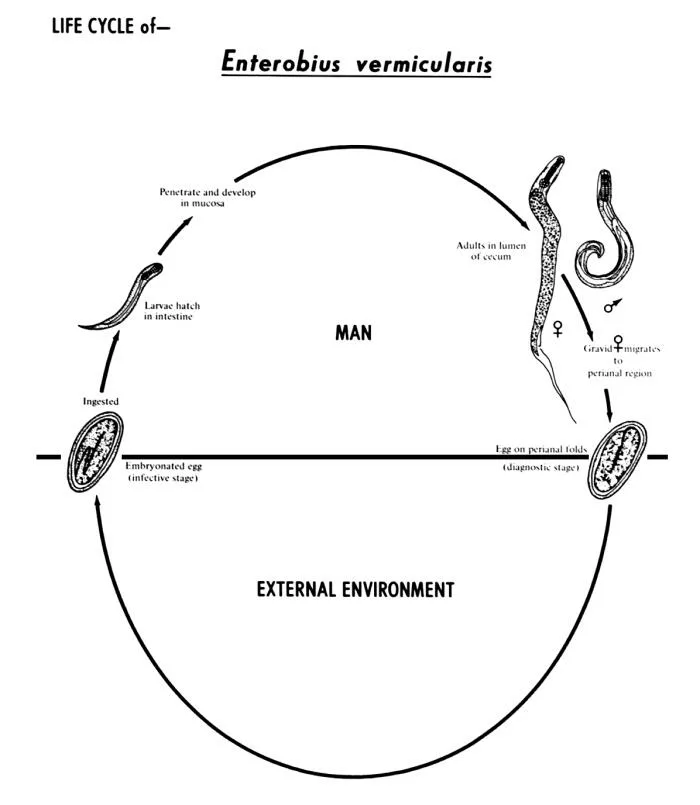
Causes of Pinworm Infection
Pinworm eggs can survive on various surfaces for up to 2 weeks, making spreading them easier. Common objects that harbor pinworm eggs are:
- Toilets
- Bed linens
- Towels
- Clothes
- Toys and other frequently touched surfaces
Eggs are transferred to these surfaces after an infected person scratches his anal area or comes in contact with the eggs during the night. Once on surfaces, these eggs can easily be picked up by others.
Ingesting Pinworm
Primarily, pinworm spreads through hand-to-mouth transmission, which occurs when an individual touches their mouth after contacting a contaminated surface. For instance, eating food without washing hands introduces pinworm eggs into the mouth. Moreover, poor hygiene is one of the most significant ways pinworms spread; notably, failing to wash hands properly before eating or neglecting to clean fingernails is a major factor in transmission. Additionally, individuals who use the same towels and bed linens without proper washing have a higher risk of infection. In some cases, drinking contaminated water can also lead to the ingestion of pinworm eggs. Finally, habits like nail biting and thumb sucking can transfer pinworm eggs from the hands to the mouth, further spreading the infection.
Crowded Living Conditions
In particular, pinworms spread more commonly in places where many people live close together. For example, conditions that increase the risk of transmission include:
- Schools and daycare centers, where children frequently interact with one another
- Bigger families, especially those where multiple people share toilets and linens
- Dormitories, camps, and nursing homes, in which individuals share communal facilities
Symptoms of pinworm infection
Pinworm is the most common parasitic infection. Some individuals may be asymptomatic, but some people, particularly children, can exhibit a range of noticeable and uncomfortable symptoms. Here’s a closer look at the symptoms associated with pinworm infection
Anal Itching
This is the hallmark symptom of enterobiasis. The itching is intense in the anal area, especially during the night. This occurs as female worms emerge from the rectum and lay eggs on the anal area.2AL-kafaji, Maani Seher Abid, and Zainab H. Alsaadi. “Pinworms Infection.” Jour Med Resh and Health Sci 5.8 (2022): 2182-2189. It irritates the skin, thus causing itching. If this itching becomes intense, frequent scratching can lead to secondary bacterial infection or skin irritation (dermatitis).

Restlessness & Insomnia
Pinworms are more active at night and can cause significant restlessness and sleep disturbances. Children wake up multiple times during the night due to itching and have difficulty falling asleep again. Moreover, chronic sleep disruption causes crankiness, mood swings, irritability, difficulty concentrating, and even poor school performance.
Nocturnal Enuresis
Not being able to control your pee during the night is called nocturnal enuresis. It is more common in children with pinworm infection.3Çulha, G., & Duran, N. (Year). The relationship between Enterobius vermicularis infection and nocturnal enuresis. Mustafa Kemal University, Medical Faculty, Departments of Parasitology and Microbiology. Retrieved from https://www.bioline.org.br/pdf?gm06004#:~:text=Besides%20this%2C%20the%20results%20indicate,%2C%20pinworm%2C%20parasite%2C%20children.
Abdominal Pain & Nausea
Although not always present, some individuals may experience mild abdominal discomfort, cramping, and nausea. In many cases, discomfort is caused by worms moving inside the intestine. Typically, pain because of pinworm infection is mild; however, in heavy infection, it can become severe. In these situations, some bowel changes can also be observed, such as diarrhea.

Loss of Appetite & Weight Loss
If there are repeated episodes of infection or if the infection remains untreated for longer periods, the patient may lose interest in food, leading to reduced appetite. When appetite loss persists, it may result in slight weight loss.
Vulvovaginitis in Female
In females, during infections, worms can be transferred from the anal region to the vagina and vulva. This leads to inflammation and is called vulvovaginitis.4Dei, Metella, et al. “Vulvovaginitis in childhood.” Best Practice & Research Clinical Obstetrics & Gynaecology 24.2 (2010): 129-137. This causes:
- Itching in the vagina and vulva
- Discharge from the vagina
- Urinary discomfort if the infection reaches the urethra (the tube through which urine leaves the body. It empties urine from the bladder)
Vulvovaginitis from pinworms is more common in young girls and can be uncomfortable and distressing. Properly managing this may increase the risk of recurrent urinary tract infections.
Appendicitis
Pinworm infection is usually benign but occasionally leads to appendicitis (inflammation of the appendix) if worms enter the appendix. This rare complication is seen in children where obstruction of the appendix causes acute pain and tenderness.5Burkhart, Craig N., and Craig G. Burkhart. “Assessment of frequency, transmission, and genitourinary complications of enterobiasis
Psychological Effects
As the children grow older, they feel embarrassed discussing anal itching symptoms with their caregiver, which leads to delays in diagnosis and treatment of the disease. Persistent infection and sleep disturbances can make children reluctant to engage in social activities. This takes a toll on their mental health, leading to psychological distress.
Diagnosis of Pinworm infection
Diagnosing pinworm infection can be straightforward without any invasive procedures. Since pinworms have distinctive features and are visible under the naked eye, they can be easily diagnosed by caregivers and healthcare professionals. Below are some of the diagnostic measures that can be taken
Observation of Symptoms
Patients, particularly children, will scratch their perianal area, especially at night. This characteristic feature prompts the caregiver to seek further professional help. Irritability, restlessness, and disturbed sleep are some of the other symptoms that caregivers may observe.
Tape Test
The tape test is the primary diagnostic test for pinworm infection. A caregiver or a healthcare provider can easily perform this test at home or in a diagnostic center. This test involves pressing a transparent adhesive tape on the perianal area first thing in the morning before using the toilet or bathing. The timing of this test is crucial because female pinworms lay eggs on the perianal area during the night. The tape is then observed under a microscope by a healthcare professional who checks the presence of pinworm eggs. Usually, this test may have to be done on several consecutive mornings as the pinworms do not lay eggs every night. This test is easy to perform and highly effective for detection of pinworms.
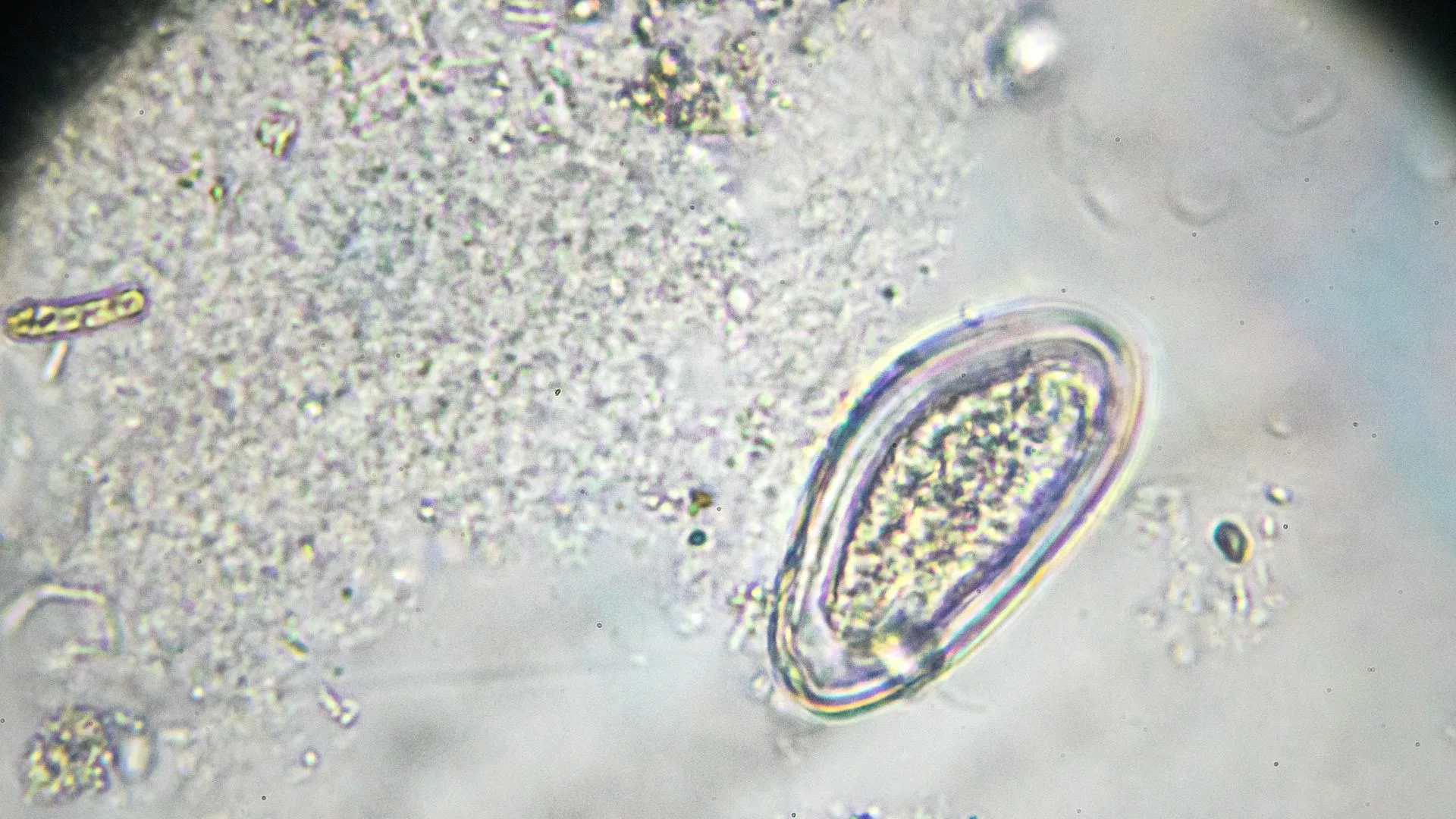
Anal Swab Test
Pharmacies and microbiological laboratories now offer readymade detection kits. One can swab the anal region with a cotton swab and then place this in a physiological saline solution. The solution can then be used in the microscopic inspection of worm eggs. This test, like the tape test, must be performed on at least three different days to increase its sensitivity.6Wendt, Sebastian, et al. “The diagnosis and treatment of pinworm infection.” Deutsches Ärzteblatt International 116.13 (2019): 213.
Stool Sample
Although a stool test is not always needed to detect pinworm infection, it can be performed if the symptoms are not clear and other parasitic infections are suspected. Unlike many other parasites, pinworm eggs are not always present in the stool, so stool samples are generally less reliable for diagnosis. However, in cases where stool samples are examined, adult worms may occasionally be seen.
Visual inspection
In some cases, pinworms can be seen without any special equipment by caregivers in the anal area during the night if the infection is severe. Adult pinworms appear as white, tiny, thread-like worms almost 0.2 to 0.4 inches long. Visual inspection can be useful for confirming this disease in case other tests are not readily available.
Serological methods are of no diagnostic relevance in detecting pinworm infection. Similarly, due to the worms’ low invasiveness, neither blood eosinophilia nor elevated immunoglobulin E levels are generally expected to rise in pinworm infestation.
Treatment of Pinworm infection
Treating pinworm infection is simple and highly effective. It can easily be treated with the right medication and hygiene practices. Although medications used for treating pinworms are effective against adult worms, the eggs are resilient, and chances of reinfection are higher until precautions are taken. Below are some of the treatment options to combat pinworm infection.
Medicines:
The following medicines are the drugs of choice for treating pinworm infection effectively.
Mebendazole
Mebendazole is a commonly prescribed medicine for pinworms. Usually, a single dose is given to eliminate the worms, but sometimes, a second dose is given two weeks after the first one to kill the remaining newly hatched worms to prevent reinfection. The mechanism of action of mebendazole is that it inhibits the ability of pinworms to absorb glucose, thus effectively starving them.7Yang CA, Liang C, Lin CL, Hsiao CT, Peng CT, Lin HC, Chang JG. Impact of Enterobius vermicularis infection and mebendazole treatment on intestinal microbiota and host immune response. PLoS Negl Trop Dis. 2017 Sep;11(9):e0005963.
Albendazole
This is also a common drug used for eliminating pinworms. It is administered in the same way as mebendazole, with one initial dose followed by a second dose after two weeks. Albendazole is sometimes the drug of choice as it kills other intestinal parasites along with Enterobius vermicularis (pinworm).
Pyrantel Pamoate
This medicine is available over the counter in many countries. It is administered in the same way as the medicines mentioned above, with one initial dose followed by a dose after two weeks. The mechanism of the action of pyrantel pamoate is that it expels worms from the digestive tract through natural bowel movements.
Preventing Reinfection:
Treating pinworms is not about medication. The main task is to prevent reinfection, which requires strict hygiene measures to eliminate any remaining eggs. Since pinworm eggs can survive on different surfaces for up to two weeks, here are some of the measures that can be taken to prevent reinfection.
Treat all Household Members
Pinworm infections are highly contagious; to prevent reinfection, it is recommended that all household members, even those who are asymptomatic, undergo treatment simultaneously.
Cleaning & Disinfecting Surfaces
Thoroughly cleaning frequently touched surfaces is essential to prevent reinfection. Regularly disinfecting bed linens, towels, carpets, rugs, bathroom surfaces, doorknobs, and light switches can help remove any eggs that may have settled in these areas. Bed linens and towels should be laundered in hot water for optimal disinfection.
Personal Hygiene
Practicing good hygiene is essential for preventing the spread and recurrence of pinworm infections. The following steps are recommended to help ensure the success of treatment. Firstly, washing hands frequently, especially after using the bathroom, changing diapers, or handling any potentially contaminated item. Secondly, nail hygiene is also important to minimize the chances of pinworm eggs getting lodged in the nails. Next, daily morning showers help wash away any eggs laid during the night. Lastly, avoid scratching the perianal area so the eggs are not transferred to the fingers.
Follow-up Care:
It is advised to look for symptoms of pinworms even after being treated with medication. Patients should consult a healthcare professional if symptoms reappear. If symptoms return, a healthcare provider may recommend a second treatment cycle. In some cases, it may also be helpful to repeat the tape test after treatment to confirm that the infection has cleared.
Difference between Pinworm & Roundworm
Enterobius (Enterobius vermicularis) and Ascaris (Ascaris lumbricoides) are commonly known as pinworm and roundworm, respectively. Although they are both parasitic digestive tract worms and have many similar gastrointestinal symptoms, they differ in their shape, size, lifecycle, modes of transmission, and medical complications. These are two distinct types of parasites. Understanding these differences is crucial for correct diagnosis.
| Features | Pinworm | Roundworm |
| Scientific Name | Enterobius vermicularis | Ascaris lumbricoides |
| Shape and size | Small, white, thread-like, ~1 cm | Larger, cylindrical, can grow up to 30 cm 8Wang, Jianbin, and Richard E. Davis. “Ascaris.” Current Biology 30.10 (2020): R423-R425. |
| Infection Method | Ingesting eggs from contaminated surfaces or hands | Ingesting eggs from contaminated soil or food |
| Primary Location in the body | Large intestine (anus and perianal area) | The small intestine, lungs |
| Symptoms | Itching around the anus, especially at night | Abdominal pain, bloating, potential malnutrition. Worms can be seen in feces. |
| Common treatment | Mebendazole, albendazole, pyrantel pamoate | Albendazole, mebendazole |
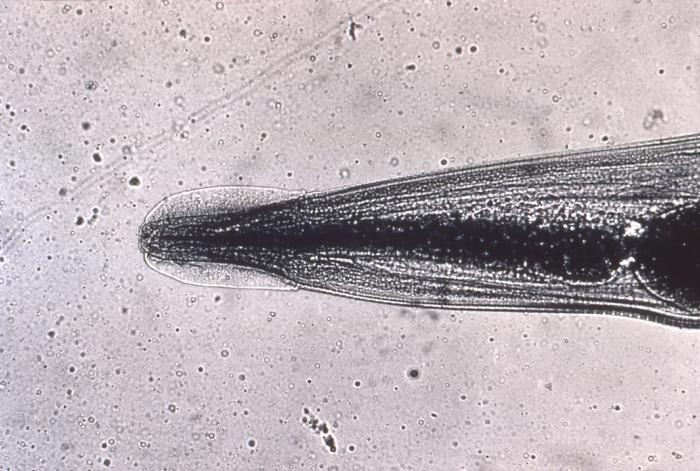
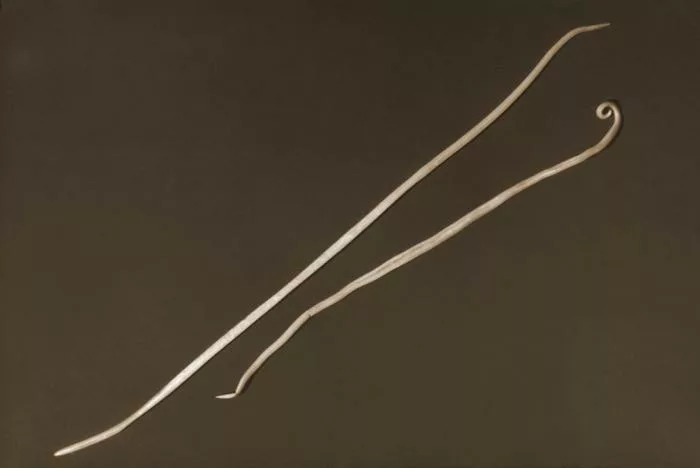
ID#10176
Conclusion
Pinworm infection is a common and easily treatable parasitic infection that primarily affects children. Understanding its causes, symptoms, and treatment options can help individuals manage the infection effectively and prevent its spread. Proper hygiene practices are also needed to avoid complications and reinfection.
Refrences
- 1Vermund, Sten H., and Craig M. Wilson. “Pinworm (Enterobius vermicularis).” Seminars in Pediatric Infectious Diseases. Vol. 11. No. 4. WB Saunders, 2000.
- 2AL-kafaji, Maani Seher Abid, and Zainab H. Alsaadi. “Pinworms Infection.” Jour Med Resh and Health Sci 5.8 (2022): 2182-2189.
- 3Çulha, G., & Duran, N. (Year). The relationship between Enterobius vermicularis infection and nocturnal enuresis. Mustafa Kemal University, Medical Faculty, Departments of Parasitology and Microbiology. Retrieved from https://www.bioline.org.br/pdf?gm06004#:~:text=Besides%20this%2C%20the%20results%20indicate,%2C%20pinworm%2C%20parasite%2C%20children.
- 4Dei, Metella, et al. “Vulvovaginitis in childhood.” Best Practice & Research Clinical Obstetrics & Gynaecology 24.2 (2010): 129-137.
- 5Burkhart, Craig N., and Craig G. Burkhart. “Assessment of frequency, transmission, and genitourinary complications of enterobiasis
- 6Wendt, Sebastian, et al. “The diagnosis and treatment of pinworm infection.” Deutsches Ärzteblatt International 116.13 (2019): 213.
- 7Yang CA, Liang C, Lin CL, Hsiao CT, Peng CT, Lin HC, Chang JG. Impact of Enterobius vermicularis infection and mebendazole treatment on intestinal microbiota and host immune response. PLoS Negl Trop Dis. 2017 Sep;11(9):e0005963.
- 8Wang, Jianbin, and Richard E. Davis. “Ascaris.” Current Biology 30.10 (2020): R423-R425.

